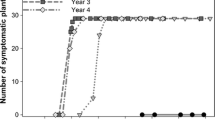Abstract
Six sequential field experiments were conducted from 1999 to 2002 to evaluate virus reinfection in garlic cv. Amarante and its effect on bulb production. The treatments in the year 1999 were: T1 – virus-free garlic-seed obtained by thermotherapy and meristem-tip culture and indexed for virus by immuno-sorbent electron microscopy (ISEM) under its first field cycle; T2, T3 and T4 – garlic-seed in the second, third and fourth field cycles, respectively; and C – standard garlic-seed from the grower (with no control of virus infection) as a control. In the years 2000 to 2002, a new plot of virus-free seed was added to the experiment and cloves from the previous treatments were again grown under field conditions. In the fourth year of experiments, the treatments comprised T1 (virus-free garlic seeds under the first field cycle) to T7 (garlic-seed in the sixth field cycle) and C. Two experiments were conducted in the years 1999 and 2000, at two locations and in the years 2001 and 2002 only one experiment per year at one location. The combined analysis of variance for all experiments indicated a significant difference between the treatments for plant height and yield. The bulbs were classified into commercial classes according the Brazilian regulation and the commercial classes 4–7 were 72 %, 60%, 59%, 53% and 35% of the total number of bulbs harvested, from T1 to T5, respectively. Virus reinfection at the end of the second field cycle, determined by serology using antisera against the most common viruses of garlic in Brazil reached 83%. Treatments T1–T7 yielded 118%, 79%, 57%, 51%, 39%, 33% and 31% higher than the control.
Similar content being viewed by others
References
Conci VC, Canavelli AE, Lunello PA and Cafrune EE (1999) Mosaico del ajo. In: Projecto de Investigaciones en Fitovirologia. Instituto de Fitopatologia y Fisiologia Vegetal-IFFIVE y Instituto Nacional de Tecnologia Agropecuária-INTA. Argentina. (p.p.ajo 1–6)
Conci VC, Bracamonte R, Aloche P, Burashi D, Lunello P, Cafrune E (2000) Producción de plantas de ajo libre de los virus transmitidos por pulgones y ácaros Horticultura Argentina 19:60
Conci VC, Canavelli AE, Lunello P, di Rienzo J, Nome SF, Zumelzu G, Italia R (2003) Yield losses associated with virus-infected garlic plants during five successive years Plant Disease 87:1411–1415
Di Fonzo CD, Ragsdale DW, Radcliffe EB, Gudmestad NC, Secor GA (1997) Seasonal abundance of aphid vectors of potato virus Y in the Red River valley of Minnesota and North Dakota Journal of Economic Entomology 90:824–831
Dusi AN (1999) Beet mosaic virus: epidemiology and damage Wageningen Agricultural University, Wageningen
Dusi AN, Peters D (1999) Beet mosaic virus: its vector and host relationships. Journal of Phytopathology 147:293–298
Dusi AN, Peters D, van der Werf W (2000) Measuring and modelling the effects of inoculation date and aphid flights on the secondary spread of Beet mosaic virus in sugar beet. Annals of Applied Biology 136:131–146
Fajardo TVM (1998) Estudo de degenerescência por viroses e caracterização molecular do complexo viral da cultura do alho Universidade de Brasília, Brasília
Fajardo TVM, Nishijima M, Buso JA, Torres AC, de Ávila AC, Resende RO (2001) Garlic viral complex: identification of potyviruses and carlavirus in central Brazil Fitopatologia Brasileira 26:619–626
Jayasinghe U and Salazar LT (1993) Ensayos inmunológicos con conjugados enzimáticos: en mambranas de nitrocelulosa (NCM-ELISA) IN: CIP – Manual de técnicas en virologia. Centro Internacional de la Papa, Lima
Liewehr DJ, Cranshaw WS (1991) Alate aphid trap capture over different background colors and different background patterns Southwestern Entomologist 16:13–18
Madden LV, Pirone TP, Raccah B (1987) Analysis of spatial patterns of virus-diseased tobacco plants Phytopathology 77:1409–1417
Melo Filho PA, Nagata T, Dusi AN, Buso JA, Torres AC, Eiras M, Resende RO (2004) Detection of three Allexivirus species infecting garlic in Brazil Pesquisa Agropecuária Brasileira 39:375–340
Menezes Sobrinho JA (1997) Cultivo do alho (Allium sativim L.) 3 ed. Embrapa Hortaliças, Brasília
Mora-Aguilera G, Nieto-Angel D, Campbell CL, Téliz D, García E (1996) Multivariate comparison of papaya ringspot epidemics Phytopathology 86:70–78
Nakamae IJ, Pastrello CP (2002) Agrianual 2002 Argos Comunicação, São Paulo
Nemecek T (1993) The Role of Aphid Behavior in the Epidemiology of Potato Virus Y: A Simulation Study Swiss Federal Institute of Technology Zürich, Obersiggental
Robert U, Z’el J, Ravnikar M (1998) Thermoterapy in virus elimination from garlic influences on shoot multiplication from meristems and bulb formation in vitro Scientia Horticulture 73:193–202
SAS Institute Inc (1999) SAS/STAT user’s guide, version 6, 4th edn. Cary, NC: SAS Institute Inc
Sigvald R (1987) Aphid migration and the importance of some aphid species as vectors of potato virus Y (PVYo) in Sweden Potato Research 30:267–283
Tanabe CMN (1999) Avaliação de degenerescência em campo causada por fitoviroses na cultura do alho (Allium sativum L.) Universidade de Brasília, Brasília
Torres AC, Fajardo TVM, Dusi AN, Resende RO, Buso JA (2000) Shoot tip culture and thermotherapy in recovering virus free plants of garlic Horticultura Brasileira 18:192–195
van Dijk P (1993) Survey and characterization of Potyviruses and their strains of Allium species Netherlands Journal of Plant Pathology 99:1–48
van Dijk P, Verbeek M, Bos L (1991) Mite-borne virus isolates from cultivated Allium species, and their classification into two new rymoviruses in the family Potyviridae Netherlands Journal of Plant Pathology 97:381–399
Wang P, Huang L (1974) Studies on the shoot meristem culture of Allium sativum Journal of the Chinese Society of Horticultural Science 20:79–87
Acknowledgements
This work was partially funded by CBAB/CNPq, Brazil. We also tank Dr. David Bertioli from the Universidade Católica de Brasília for the critical review of both English and content of the manuscript.
Author information
Authors and Affiliations
Corresponding author
Rights and permissions
About this article
Cite this article
Filho, P.d.A.M., Resende, R.O., Cordeiro, C.M.T. et al. Viral reinfection affecting bulb production in garlic after seven years of cultivation under field conditions. Eur J Plant Pathol 116, 95–101 (2006). https://doi.org/10.1007/s10658-006-9042-3
Accepted:
Published:
Issue Date:
DOI: https://doi.org/10.1007/s10658-006-9042-3




